Soil Penetration Resistance after One-Time Inversion Tillage: A Spatio-Temporal Analysis at the Field Scale
Abstract
1. Introduction
2. Materials and Methods
2.1. Study Area
2.2. Measurement Design and Field Work
2.3. Laboratory Analyses
2.4. Descriptive and Spatial Statistical Analyses
- (i)
- deterministic inverse distance weighting method (“gstat”, [71])
- (ii)
- geostatistical regionalization method ordinary kriging (“gstat”, [71]])
- (iii)
- (iv)
- procedures which combine geostatistical and machine learning methods such as kriging with external drift, regression tree kriging and random forest kriging (according to [65])
3. Results
3.1. Penetration Resistance at Plot Scale
3.2. Spatial Patterns of Penetration Resistance
3.3. Soil Moisture, Bulk Density, Soil Texture and Carbon Content
4. Discussion
4.1. Temporal Effects of OTIT on Soil Penetration Resistance
4.2. Spatial Effects of OTIT on Penetration Resistance
4.3. Assessment, Advances and Limitations of Penetration Resistance Measurements
5. Conclusions
Supplementary Materials
Author Contributions
Funding
Acknowledgments
Conflicts of Interest
References
- Pittelkow, C.M.; Liang, X.; Linquist, B.A.; Van Groenigen, K.J.; Lee, J.; Lundy, M.E.; Van Gestel, N.; Six, J.; Venterea, R.T.; Van Kessel, C. Productivity limits and potentials of the principles of conservation agriculture. Nature 2015, 517, 365–368. [Google Scholar] [CrossRef]
- Kassam, A.; Friedrich, T.; Derpsch, R. Global spread of Conservation Agriculture. Int. J. Environ. Stud. 2018, 76, 29–51. [Google Scholar] [CrossRef]
- Prestele, R.; Hirsch, A.L.; Davin, E.L.; Seneviratne, S.I.; Verburg, P.H. A spatially explicit representation of conservation agriculture for application in global change studies. Glob. Chang. Biol. 2018, 24, 4038–4053. [Google Scholar] [CrossRef] [PubMed]
- Busari, M.A.; Kukal, S.S.; Kaur, A.; Bhatt, R.; Dulazi, A.A. Conservation tillage impacts on soil, crop and the environment. Int. Soil Water Conserv. Res. 2015, 3, 119–129. [Google Scholar] [CrossRef]
- Sanaullah, M.; Usman, M.; Wakeel, A.; Cheema, S.A.; Ashraf, I.; Farooq, M. Terrestrial ecosystem functioning affected by agricultural management systems: A review. Soil Tillage Res. 2020, 196, 104464. [Google Scholar] [CrossRef]
- FAO. Conservation Agriculture—Revised Version; AG Dept Factsheets: Rome, Italy, 2017. [Google Scholar]
- Luo, Z.; Wang, E.; Sun, O.J. Soil carbon change and its responses to agricultural practices in Australian agro-ecosystems: A review and synthesis. Geoderma 2010, 155, 211–223. [Google Scholar] [CrossRef]
- Li, Y.; Chang, S.X.; Tian, L.; Zhang, Q. Conservation agriculture practices increase soil microbial biomass carbon and nitrogen in agricultural soils: A global meta-analysis. Soil Biol. Biochem. 2018, 121, 50–58. [Google Scholar] [CrossRef]
- Horn, R. Time Dependence of Soil Mechanical Properties and Pore Functions for Arable Soils. Soil Sci. Soc. Am. J. 2004, 68, 1131–1137. [Google Scholar] [CrossRef]
- Tebrügge, F.; Düring, R.-A. Reducing tillage intensity—A review of results from a long-term study in Germany. Soil Tillage Res. 1999, 53, 15–28. [Google Scholar] [CrossRef]
- Lal, R.; Reicosky, D.C.; Hanson, J.D. Evolution of the plow over 10,000 years and the rationale for no-till farming. Soil Tillage Res. 2007, 93, 1–12. [Google Scholar] [CrossRef]
- Lal, R. Restoring Soil Quality to Mitigate Soil Degradation. Sustainability 2015, 7, 5875–5895. [Google Scholar] [CrossRef]
- Nail, E.L.; Young, D.L.; Schillinger, W.F. Diesel and glyphosate price changes benefit the economics of conservation tillage versus traditional tillage. Soil Tillage Res. 2007, 94, 321–327. [Google Scholar] [CrossRef]
- Lahmar, R. Adoption of conservation agriculture in Europe: Lessons of the KASSA project. Land Use Policy 2010, 27, 4–10. [Google Scholar] [CrossRef]
- Lou, Y.; Xu, M.; Chen, X.; He, X.; Zhao, K. Stratification of soil organic C, N and C:N ratio as affected by conservation tillage in two maize fields of China. CATENA 2012, 95, 124–130. [Google Scholar] [CrossRef]
- Deubel, A.; Hofmann, B.; Orzessek, D. Long-term effects of tillage on stratification and plant availability of phosphate and potassium in a loess chernozem. Soil Tillage Res. 2011, 117, 85–92. [Google Scholar] [CrossRef]
- Bajwa, A.A. Sustainable weed management in conservation agriculture. Crop Prot. 2014, 65, 105–113. [Google Scholar] [CrossRef]
- Nichols, V.; Verhulst, N.; Cox, R.; Govaerts, B. Weed dynamics and conservation agriculture principles: A review. Field Crops Res. 2015, 183, 56–68. [Google Scholar] [CrossRef]
- Destain, M.-F.; Roisin, C.; Dalcq, A.-S.; Mercatoris, B.C.N. Effect of wheel traffic on the physical properties of a Luvisol. Geoderma 2016, 262, 276–284. [Google Scholar] [CrossRef]
- Blanco-Canqui, H.; Ruis, S.J. No-tillage and soil physical environment. Geoderma 2018, 326, 164–200. [Google Scholar] [CrossRef]
- Nunes, M.R.; Denardin, J.E.; Pauletto, E.A.; Faganello, A.; Pinto, L.F.S. Mitigation of clayey soil compaction managed under no-tillage. Soil Tillage Res. 2015, 148, 119–126. [Google Scholar] [CrossRef]
- Bogunovic, I.; Pereira, P.; Kisic, I.; Sajko, K.; Sraka, M. Tillage management impacts on soil compaction, erosion and crop yield in Stagnosols (Croatia). CATENA 2018, 160, 376–384. [Google Scholar] [CrossRef]
- D’Haene, K.; Vermang, J.; Cornelis, W.M.; Leroy, B.L.M.; Schiettecatte, W.; de Neve, S.; Gabriels, D.; Hofman, G. Reduced tillage effects on physical properties of silt loam soils growing root crops. Soil Tillage Res. 2008, 99, 279–290. [Google Scholar] [CrossRef]
- Daraghmeh, O.A.; Jensen, J.R.; Petersen, C.T. Soil structure stability under conventional and reduced tillage in a sandy loam. Geoderma 2009, 150, 64–71. [Google Scholar] [CrossRef]
- Vogeler, I.; Horn, R.; Wetzel, H.; Krümmelbein, J. Tillage effects on soil strength and solute transport. Soil Tillage Res. 2006, 88, 193–204. [Google Scholar] [CrossRef]
- Dang, Y.P.; Seymour, N.P.; Walker, S.R.; Bell, M.J.; Freebairn, D.M. Strategic tillage in no-till farming systems in Australia’s northern grains-growing regions: I. Drivers and implementation. Soil Tillage Res. 2015, 152, 104–114. [Google Scholar] [CrossRef]
- Dang, Y.P.; Moody, P.W.; Bell, M.J.; Seymour, N.P.; Dalal, R.C.; Freebairn, D.M.; Walker, S.R. Strategic tillage in no-till farming systems in Australia’s northern grains-growing regions: II. Implications for agronomy, soil and environment. Soil Tillage Res. 2015, 152, 115–123. [Google Scholar] [CrossRef]
- Dang, Y.P.; Balzer, A.; Crawford, M.; Rincon-Florez, V.; Liu, H.; Melland, A.R.; Antille, D.; Kodur, S.; Bell, M.J.; Whish, J.P.M.; et al. Strategic tillage in conservation agricultural systems of north-eastern Australia: Why, where, when and how? Environ. Sci. Pollut. Res. Int. 2018, 25, 1000–1015. [Google Scholar] [CrossRef]
- Baan, C.D.; Grevers, M.C.J.; Schoenau, J.J. Effects of a single cycle of tillage on long-term no-till prairie soils. Can. J. Soil Sci. 2009, 89, 521–530. [Google Scholar] [CrossRef]
- Crawford, M.H.; Rincon-Florez, V.; Balzer, A.; Dang, Y.P.; Carvalhais, L.C.; Liu, H.; Schenk, P.M. Changes in the soil quality attributes of continuous no-till farming systems following a strategic tillage. Soil Res. 2015, 53, 263–273. [Google Scholar] [CrossRef]
- Quincke, J.A.; Wortmann, C.S.; Mamo, M.; Franti, T.; Drijber, R.A.; García, J.P. One-Time Tillage of No-Till Systems. Agron. J. 2007, 99, 1104–1110. [Google Scholar] [CrossRef]
- Kuhwald, M.; Blaschek, M.; Brunotte, J.; Duttmann, R. Comparing soil physical properties from continuous conventional tillage with long-term reduced tillage affected by one-time inversion. Soil Use Manag. 2017, 33, 611–619. [Google Scholar] [CrossRef]
- Çelik, İ.; Günal, H.; Acar, M.; Acir, N.; Bereket Barut, Z.; Budak, M. Strategic tillage may sustain the benefits of long-term no-till in a Vertisol under Mediterranean climate. Soil Tillage Res. 2019, 185, 17–28. [Google Scholar] [CrossRef]
- Blanco-Canqui, H.; Wortmann, C.S. Does occasional tillage undo the ecosystem services gained with no-till: A review. Soil Tillage Res. 2020, 198, 104534. [Google Scholar] [CrossRef]
- Peixoto, D.S.; Silva, L.d.C.M.d.; Melo, L.B.B.d.; Azevedo, R.P.; Araújo, B.C.L.; Carvalho, T.S.d.; Moreira, S.G.; Curi, N.; Silva, B.M. Occasional tillage in no-tillage systems: A global meta-analysis. Sci. Total Environ. 2020, 745, 140887. [Google Scholar] [CrossRef] [PubMed]
- Peixoto, D.S.; Silva, B.M.; Oliveira, G.C.d.; Moreira, S.G.; da Silva, F.; Curi, N. A soil compaction diagnosis method for occasional tillage recommendation under continuous no tillage system in Brazil. Soil Tillage Res. 2019, 194, 104307. [Google Scholar] [CrossRef]
- Crawford, M.H.; Bell, K.; Kodur, S.; Dang, Y.P. The Influence of Tillage Frequency on Crop Productivity in Sub-Tropical to Semi-Arid Climates. J. Crop Sci. Biotechnol. 2018, 21, 13–22. [Google Scholar] [CrossRef]
- Liu, H.; Crawford, M.; Carvalhais, L.C.; Dang, Y.P.; Dennis, P.G.; Schenk, P.M. Strategic tillage on a Grey Vertosol after fifteen years of no-till management had no short-term impact on soil properties and agronomic productivity. Geoderma 2016, 267, 146–155. [Google Scholar] [CrossRef]
- Kettler, T.A.; Lyon, D.J.; Doran, J.W.; Powers, W.L.; Stroup, W.W. Soil Quality Assessment after Weed-Control Tillage in a No-Till Wheat–Fallow Cropping System. Soil Sci. Soc. Am. J. 2000, 64, 339–346. [Google Scholar] [CrossRef]
- Baker, D.B.; Johnson, L.T.; Confesor, R.B.; Crumrine, J.P. Vertical Stratification of Soil Phosphorus as a Concern for Dissolved Phosphorus Runoff in the Lake Erie Basin. J. Environ. Qual. 2017, 46, 1287–1295. [Google Scholar] [CrossRef]
- Melland, A.R.; Antille, D.L.; Dang, Y.P. Effects of strategic tillage on short-term erosion, nutrient loss in runoff and greenhouse gas emissions. Soil Res. 2017, 55, 201. [Google Scholar] [CrossRef]
- Smith, D.R.; Warnemuende, E.A.; Huang, C.; Heathman, G.C. How does the first year tilling a long-term no-tillage field impact soluble nutrient losses in runoff? Soil Tillage Res. 2007, 95, 11–18. [Google Scholar] [CrossRef]
- Chauhan, B.S.; Singh, R.G.; Mahajan, G. Ecology and management of weeds under conservation agriculture: A review. Crop Prot. 2012, 38, 57–65. [Google Scholar] [CrossRef]
- Renton, M.; Flower, K.C. Occasional mouldboard ploughing slows evolution of resistance and reduces long-term weed populations in no-till systems. Agric. Syst. 2015, 139, 66–75. [Google Scholar] [CrossRef]
- Nunes, M.R.; Pauletto, E.A.; Denardin, J.E.; Suzuki, L.E.A.S.; van Es, H.M. Dynamic changes in compressive properties and crop response after chisel tillage in a highly weathered soil. Soil Tillage Res. 2019, 186, 183–190. [Google Scholar] [CrossRef]
- Leao, T.P.; da Silva, A.P.; Tormena, C.A.; Giarola, N.F.; Figueiredo, G.C. Assessing the immediate and residual effects of chiseling for ameliorating soil compaction under long-term no-tillage. J. Soil Water Conserv. 2014, 69, 431–438. [Google Scholar] [CrossRef]
- Townsend, T.J.; Ramsden, S.J.; Wilson, P. How do we cultivate in England? Tillage practices in crop production systems. Soil Use Manag. 2016, 32, 106–117. [Google Scholar] [CrossRef]
- Salem, H.M.; Valero, C.; Muñoz, M.Á.; Rodríguez, M.G.; Silva, L.L. Short-term effects of four tillage practices on soil physical properties, soil water potential, and maize yield. Geoderma 2015, 237–238, 60–70. [Google Scholar] [CrossRef]
- Alvarez, R.; Steinbach, H.S. A review of the effects of tillage systems on some soil physical properties, water content, nitrate availability and crops yield in the Argentine Pampas. Soil Tillage Res. 2009, 104, 1–15. [Google Scholar] [CrossRef]
- Augustin, K.; Kuhwald, M.; Brunotte, J.; Duttmann, R. Wheel Load and Wheel Pass Frequency as Indicators for Soil Compaction Risk: A Four-Year Analysis of Traffic Intensity at Field Scale. Geosciences 2020, 10, 292. [Google Scholar] [CrossRef]
- FAO. World reference base for soil resources. International soil classification system for naming soils and creating legends for soil maps. In World Soil Resources Report 106; FAO: Rome, Italy, 2014. [Google Scholar]
- DWD. Climate Data Center (CDC). Available online: https://cdc.dwd.de/portal/ (accessed on 21 August 2020).
- Arriaga, F.J.; Lowery, B.; Raper, R. Soil Penetrometers and Penetrability. In Encyclopedia of Agrophysics; Gliński, J., Horabik, J., Lipiec, J., Eds.; Springer Netherlands: Dordrecht, The Netherlands, 2011; pp. 757–760. ISBN 978-90-481-3585-1. [Google Scholar]
- Beyer, H.L. Geospatial Modelling Environment (Version 0.7.2.1). Available online: http://www.spatialecology.com/gme/ (accessed on 3 March 2014).
- Duttmann, R.; Brunotte, J.; Bach, M. Spatial analyses of field traffic intensity and modeling of changes in wheel load and ground contact pressure in individual fields during a silage maize harvest. Soil Tillage Res. 2013, 126, 100–111. [Google Scholar] [CrossRef]
- Kumar, A.; Chen, Y.; Sadek, A.; Rahman, S. Soil cone index in relation to soil texture, moisture content, and bulk density for no-tillage and conventional tillage. Agric. Eng. Int. CIGR J. 2012, 14, 26–37. [Google Scholar]
- Dexter, A.R.; Czyż, E.A.; Gaţe, O.P. A method for prediction of soil penetration resistance. Soil Tillage Res. 2007, 93, 412–419. [Google Scholar] [CrossRef]
- Kılıç, K.; Özgöz, E.; Akbaş, F. Assessment of spatial variability in penetration resistance as related to some soil physical properties of two fluvents in Turkey. Soil Tillage Res. 2004, 76, 1–11. [Google Scholar] [CrossRef]
- Vaz, C.M.P.; Manieri, J.M.; de Maria, I.C.; Tuller, M. Modeling and correction of soil penetration resistance for varying soil water content. Geoderma 2011, 166, 92–101. [Google Scholar] [CrossRef]
- Vaz, C.M.P.; Bassoi, L.H.; Hopmans, J.W. Contribution of water content and bulk density to field soil penetration resistance as measured by a combined cone penetrometer–TDR probe. Soil Tillage Res. 2001, 60, 35–42. [Google Scholar] [CrossRef]
- Gee, G.W.; Bauder, J.W. Particle-size Analysis. In Methods of Soil Analysis: Part 1; Soil Science Society of America; American Society of Agronomy: Madison, WI, USA, 1986; pp. 383–411. [Google Scholar]
- Blake, G.R.; Hartge, K.H. Bulk density. In Methods of Soil Analysis: Part 1; Soil Science Society of America; American Society of Agronomy: Madison, WI, USA, 1986; pp. 363–375. [Google Scholar]
- Gardner, W.H. Water Content. In Methods of Soil Analysis: Part 1; Soil Science Society of America; American Society of Agronomy: Madison, WI, USA, 1986; pp. 493–544. [Google Scholar]
- R Core Team. R: A Language and Environment for Statistical Computing; R Foundation for Statistical Computing: Vienna, Austria, 2020. [Google Scholar]
- Hamer, W.B.; Birr, T.; Verreet, J.-A.; Duttmann, R.; Klink, H. Spatio-Temporal Prediction of the Epidemic Spread of Dangerous Pathogens Using Machine Learning Methods. IJGI 2020, 9, 44. [Google Scholar] [CrossRef]
- De Gruijter, J.J.; Walvoort, D.J.J.; van Gams, P.F.M. Continuous soil maps—A fuzzy set approach to bridge the gap between aggregation levels of process and distribution models. Geoderma 1997, 77, 169–195. [Google Scholar] [CrossRef]
- Walvoort, D.J.J.; De Gruijter, J.J. Compositional Kriging: A Spatial Interpolation Method for Compositional Data. Math. Geol. 2001, 33, 951–966. [Google Scholar] [CrossRef]
- Yao, X.; Yu, K.; Deng, Y.; Liu, J.; Lai, Z. Spatial variability of soil organic carbon and total nitrogen in the hilly red soil region of Southern China. J. For. Res. 2019, 210, 455. [Google Scholar] [CrossRef]
- Hu, C.; Li, F.; Xie, Y.H.; Deng, Z.M.; Hou, Z.Y.; Li, X. Spatial distribution and stoichiometry of soil carbon, nitrogen and phosphorus along an elevation gradient in a wetland in China. Eur. J. Soil Sci. 2019. [Google Scholar] [CrossRef]
- Erjavec, N. Dummy Variables. International Encyclopedia of Statistical Science; Springer: Berlin/Heidelberg, Germany, 2011; pp. 407–408. [Google Scholar]
- Pebesma, E.J. Multivariable geostatistics in S: The gstat package. Comput. Geosci. 2004, 30, 683–691. [Google Scholar] [CrossRef]
- Therneau, T.; Atkinson, B. Rpart: Recursive Partitioning and Regression Trees. R Package Version 4.1-15. Available online: https://github.com/bethatkinson/rpart (accessed on 10 August 2020).
- Liaw, A.; Wiener, M. Classification and Regression by randomForest. R. News 2002, 2, 18–22. [Google Scholar]
- Jirků, V.; Kodešová, R.; Nikodem, A.; Mühlhanselová, M.; Žigová, A. Temporal variability of structure and hydraulic properties of topsoil of three soil types. Geoderma 2013, 204–205, 43–58. [Google Scholar] [CrossRef]
- Kuhwald, M.; Blaschek, M.; Minkler, R.; Nazemtseva, Y.; Schwanebeck, M.; Winter, J.; Duttmann, R. Spatial analysis of long-term effects of different tillage practices based on penetration resistance. Soil Use Manag. 2016, 32, 240–249. [Google Scholar] [CrossRef]
- Whalley, W.R.; To, J.; Kay, B.D.; Whitmore, A.P. Prediction of the penetrometer resistance of soils with models with few parameters. Geoderma 2007, 137, 370–377. [Google Scholar] [CrossRef]
- Gao, W.; Watts, C.W.; Ren, T.; Whalley, W.R. The effects of compaction and soil drying on penetrometer resistance. Soil Tillage Res. 2012, 125, 14–22. [Google Scholar] [CrossRef]
- Peth, S.; Horn, R.; Fazekas, O.; Richards, B.G. Heavy soil loading its consequence for soil structure, strength, deformation of arable soils. J. Plant Nutr. Soil Sci. 2006, 169, 775–783. [Google Scholar] [CrossRef]
- Kuhwald, M.; Dörnhöfer, K.; Oppelt, N.; Duttmann, R. Spatially Explicit Soil Compaction Risk Assessment of Arable Soils at Regional Scale: The SaSCiA-Model. Sustainability 2018, 10, 1618. [Google Scholar] [CrossRef]
- Koch, H.-J.; Dieckmann, J.; Büchse, A.; Märländer, B. Yield decrease in sugar beet caused by reduced tillage and direct drilling. Eur. J. Agron. 2009, 30, 101–109. [Google Scholar] [CrossRef]
- Pardo, A.; Amato, M.; Chiarandà, F.Q. Relationships between soil structure, root distribution and water uptake of chickpea (Cicer arietinum L.). Plant growth and water distribution. Eur. J. Agron. 2000, 13, 39–45. [Google Scholar] [CrossRef]
- Otto, R.; Silva, A.P.; Franco, H.C.J.; Oliveira, E.C.A.; Trivelin, P.C.O. High soil penetration resistance reduces sugarcane root system development. Soil Tillage Res. 2011, 117, 201–210. [Google Scholar] [CrossRef]
- Bengough, A.G.; McKenzie, B.M.; Hallett, P.D.; Valentine, T.A. Root elongation, water stress, and mechanical impedance: A review of limiting stresses and beneficial root tip traits. J. Exp. Bot. 2011, 62, 59–68. [Google Scholar] [CrossRef] [PubMed]
- Botta, G.F.; Tolon-Becerra, A.; Lastra-Bravo, X.; Tourn, M. Tillage and traffic effects (planters and tractors) on soil compaction and soybean (Glycine max L.) yields in Argentinean pampas. Soil Tillage Res. 2010, 110, 167–174. [Google Scholar] [CrossRef]
- Braunack, M.V.; Johnston, D.B. Changes in soil cone resistance due to cotton picker traffic during harvest on Australian cotton soils. Soil Tillage Res. 2014, 140, 29–39. [Google Scholar] [CrossRef]
- Barik, K.; Aksakal, E.L.; Islam, K.R.; Sari, S.; Angin, I. Spatial variability in soil compaction properties associated with field traffic operations. CATENA 2014, 120, 122–133. [Google Scholar] [CrossRef]
- Gozubuyuk, Z.; Sahin, U.; Ozturk, I.; Celik, A.; Adiguzel, M.C. Tillage effects on certain physical and hydraulic properties of a loamy soil under a crop rotation in a semi-arid region with a cool climate. CATENA 2014, 118, 195–205. [Google Scholar] [CrossRef]
- Bayat, H.; Kolahchi, Z.; Valaey, S.; Rastgou, M.; Mahdavi, S. Iron and magnesium nano-oxide effects on some physical and mechanical properties of a loamy Hypocalcic Cambisol. Geoderma 2019, 335, 57–68. [Google Scholar] [CrossRef]
- Peixoto, D.S.; Silva, B.M.; Godinho Silva, S.H.; Karlen, D.L.; Moreira, S.G.; Pereira da Silva, A.A.; Vilela de Resende, Á.; Norton, L.D.; Curi, N. Diagnosing, Ameliorating, and Monitoring Soil Compaction in No-Till Brazilian Soils. Agrosyst. Geosci. Environ. 2019, 2, 1–14. [Google Scholar] [CrossRef]
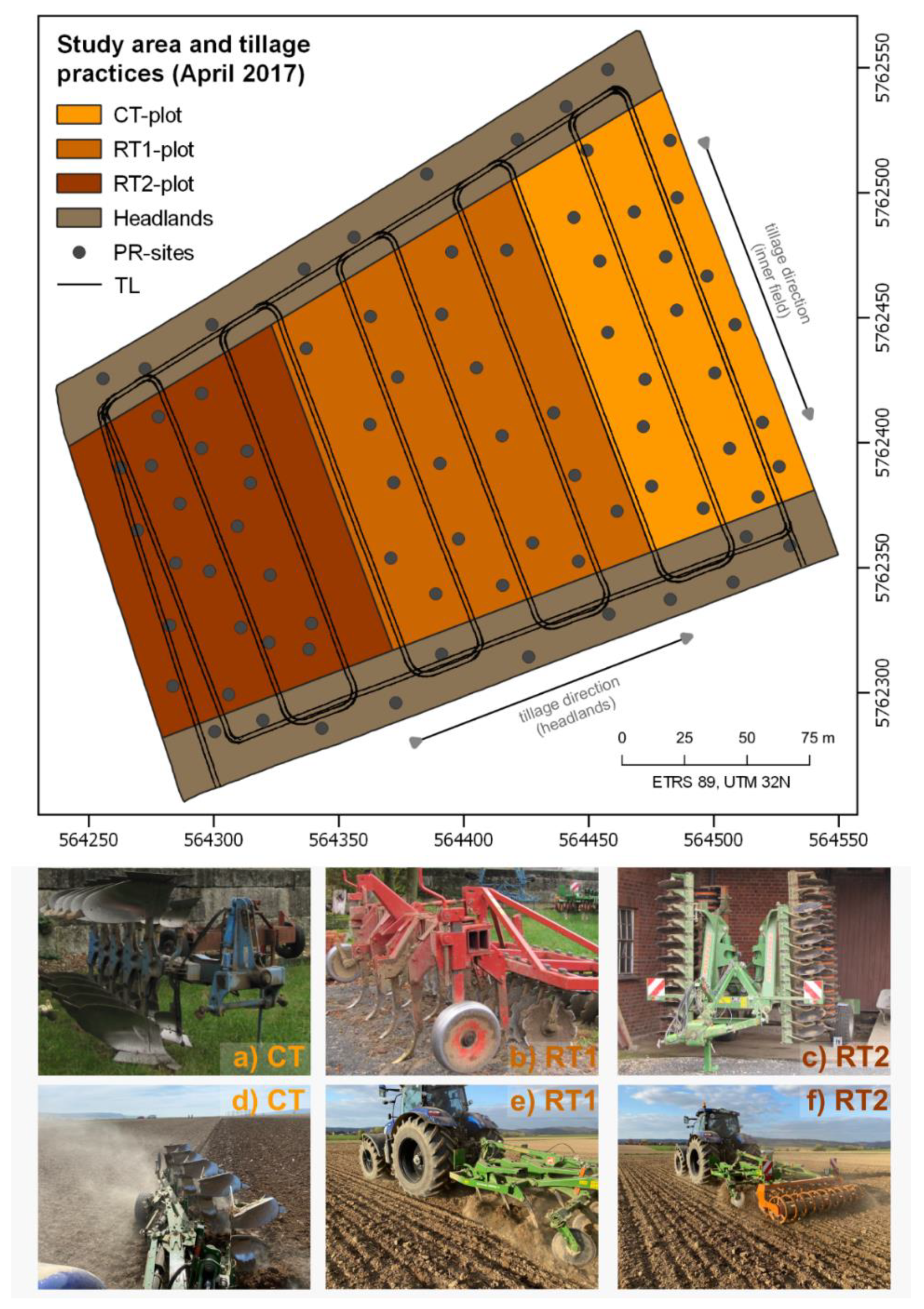
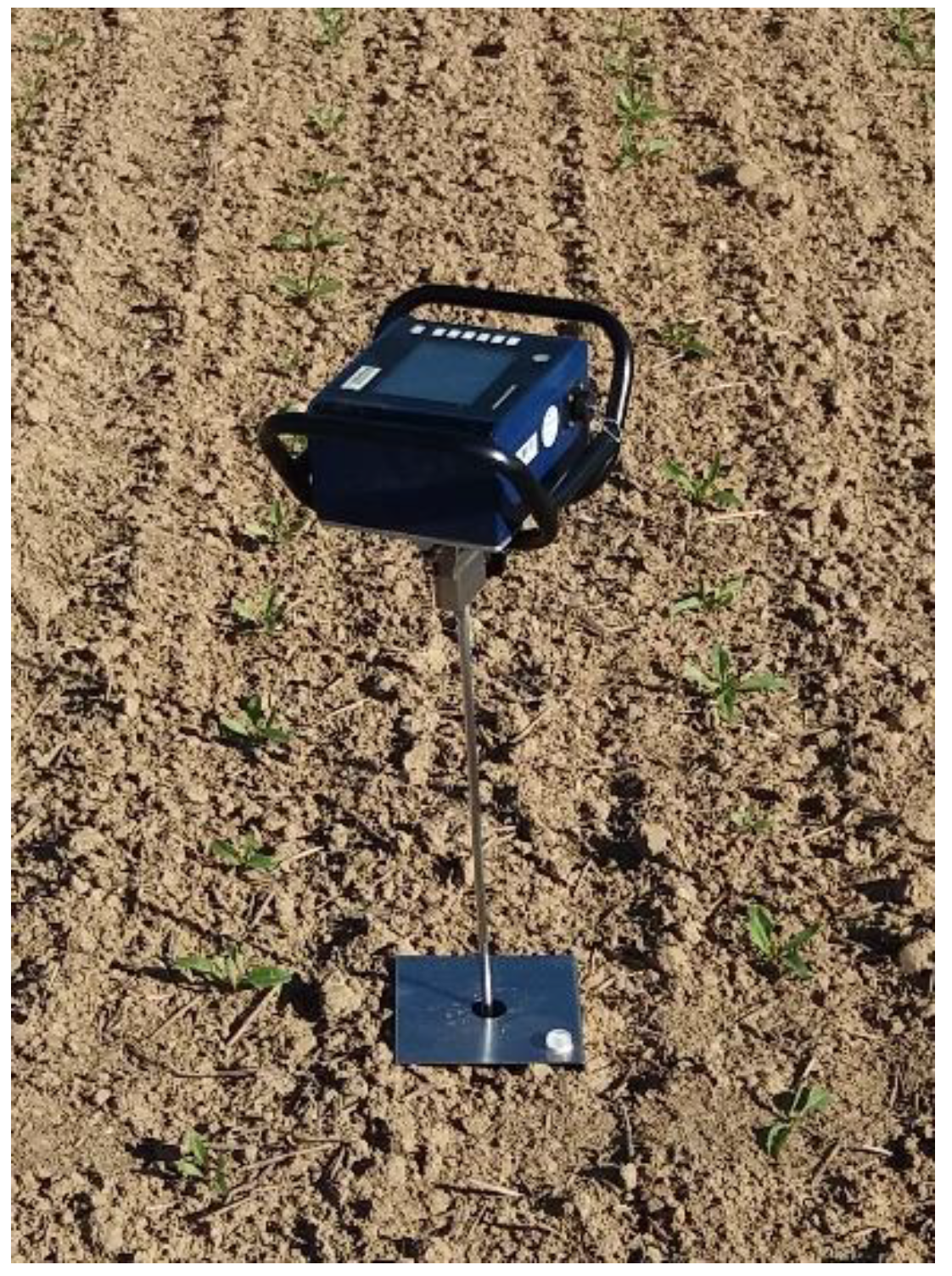
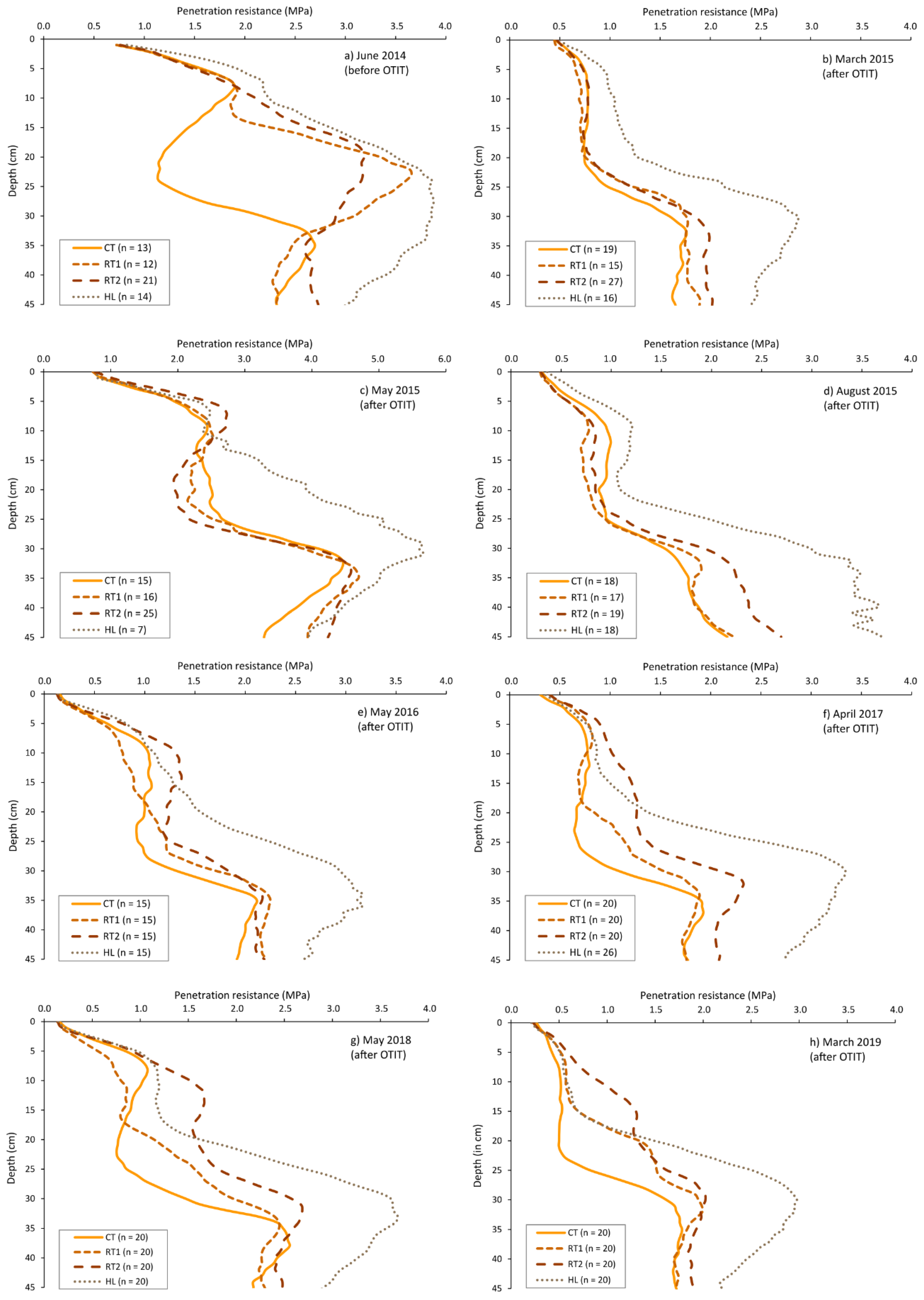
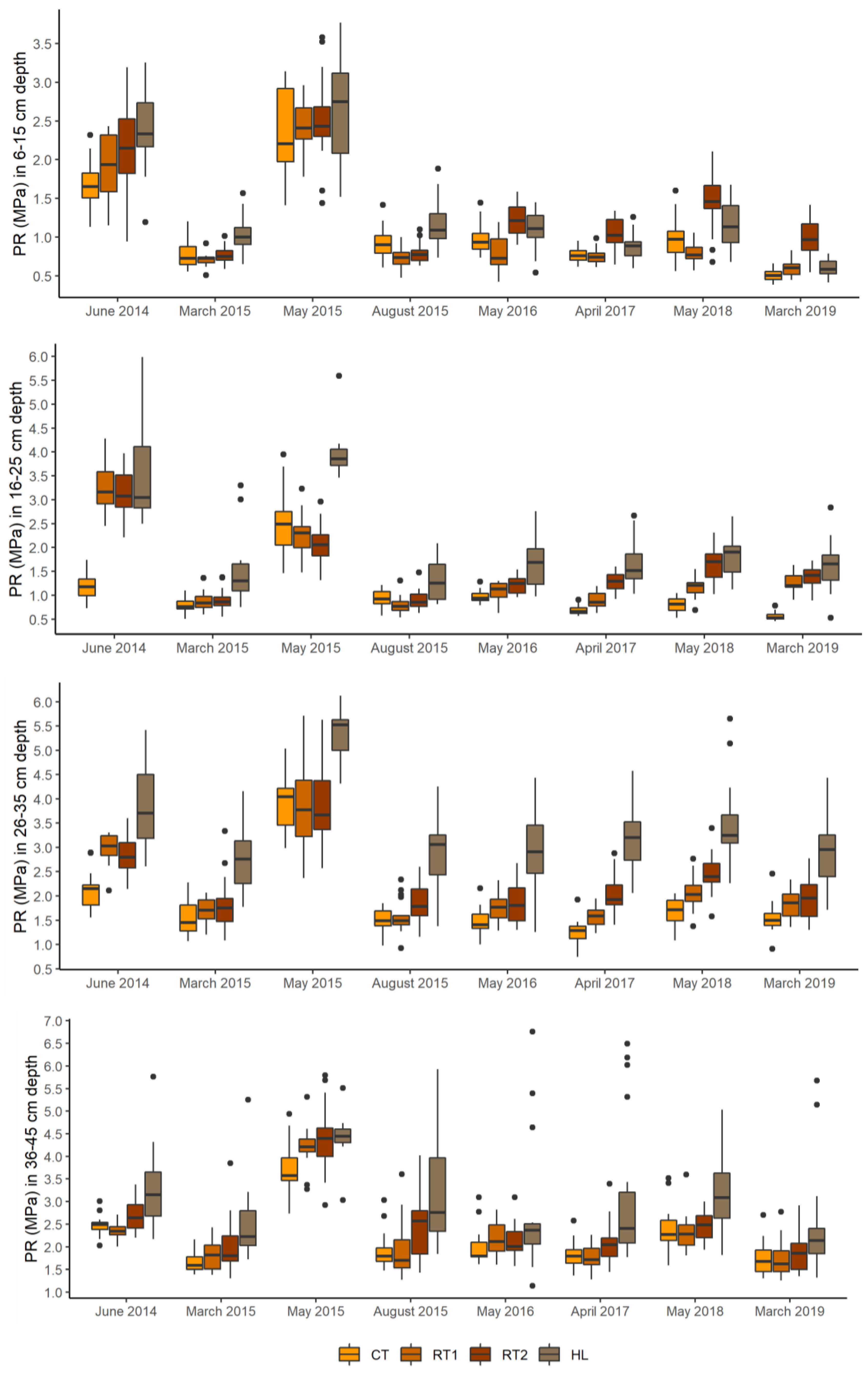
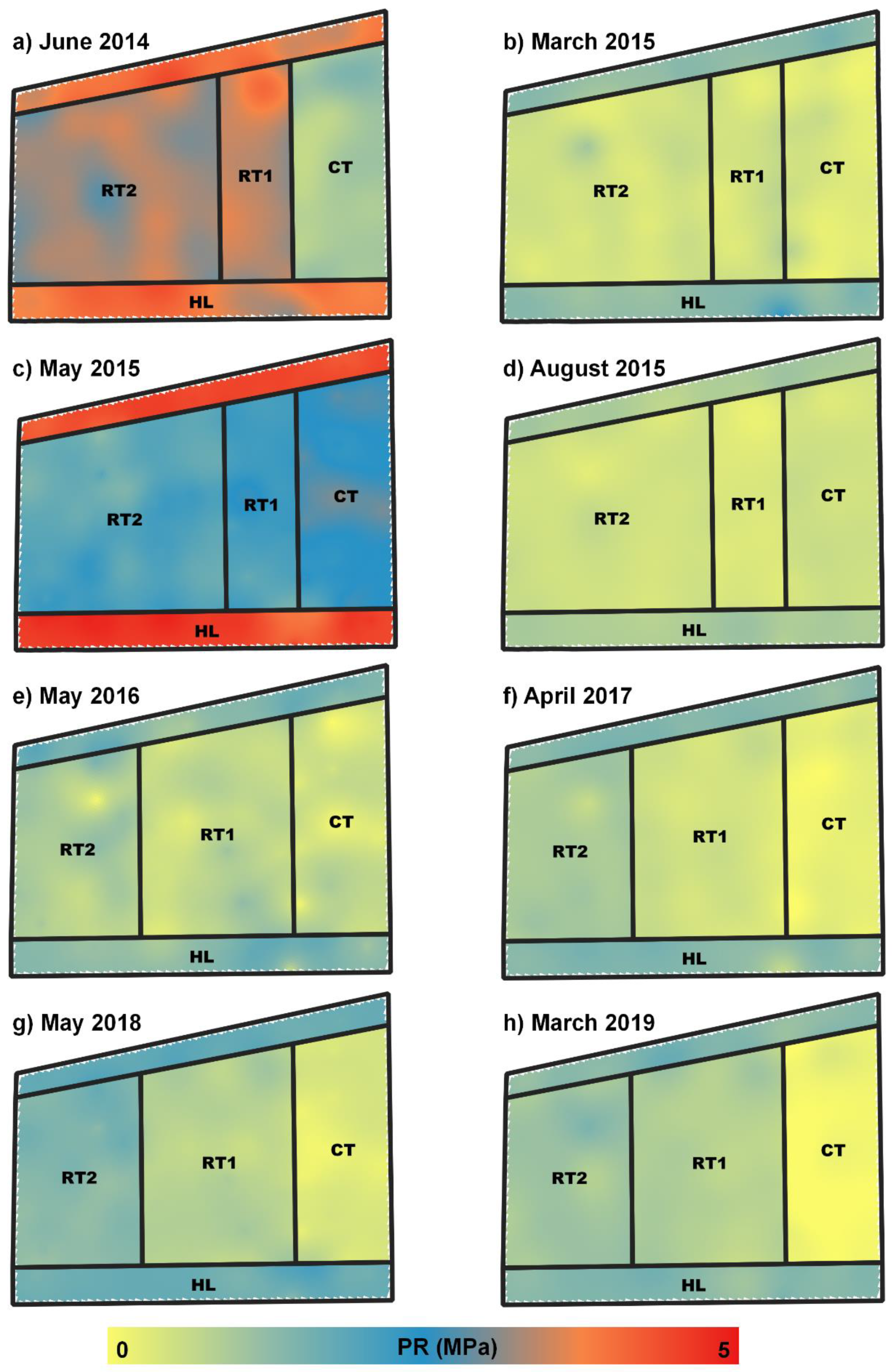
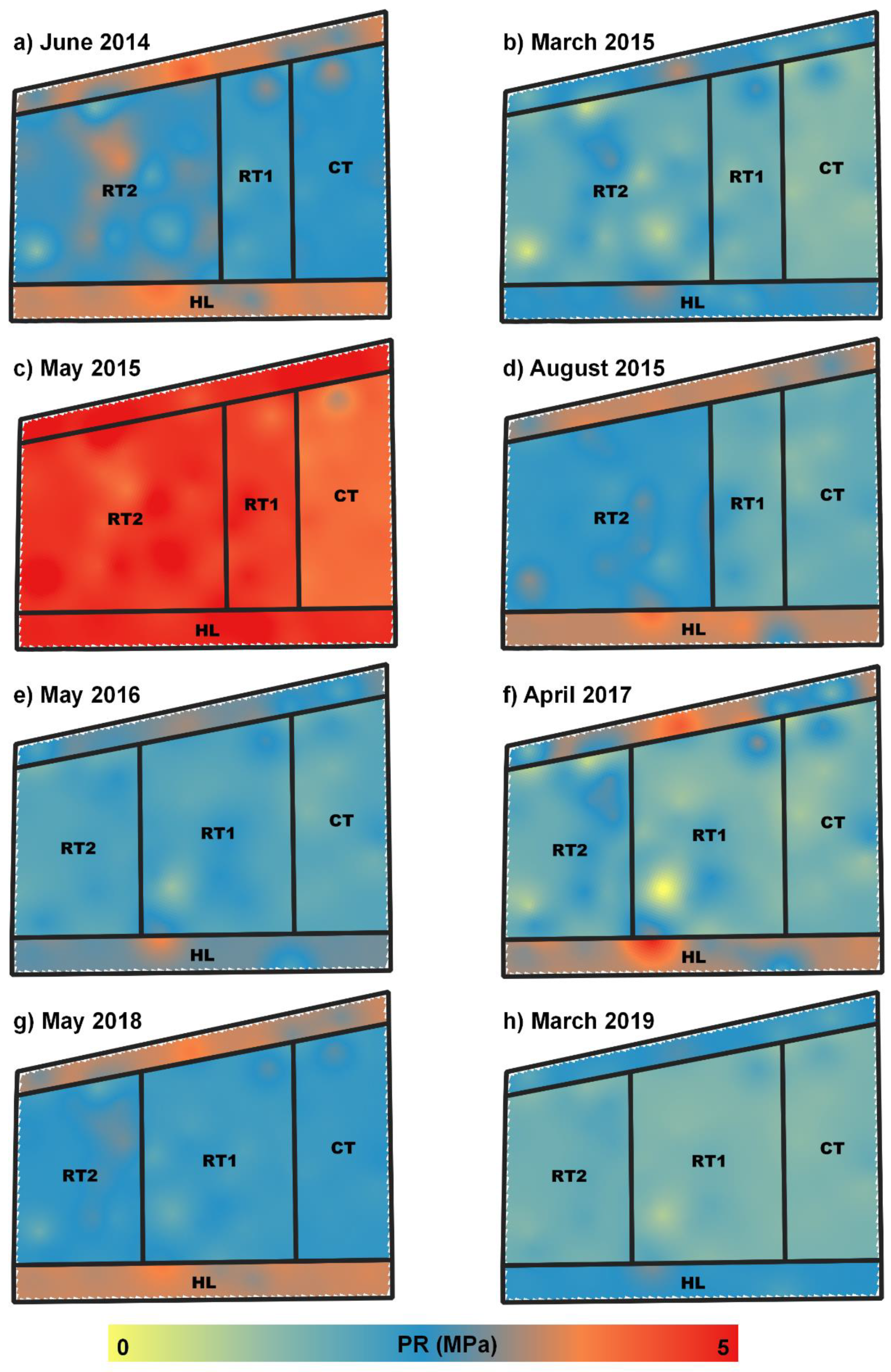
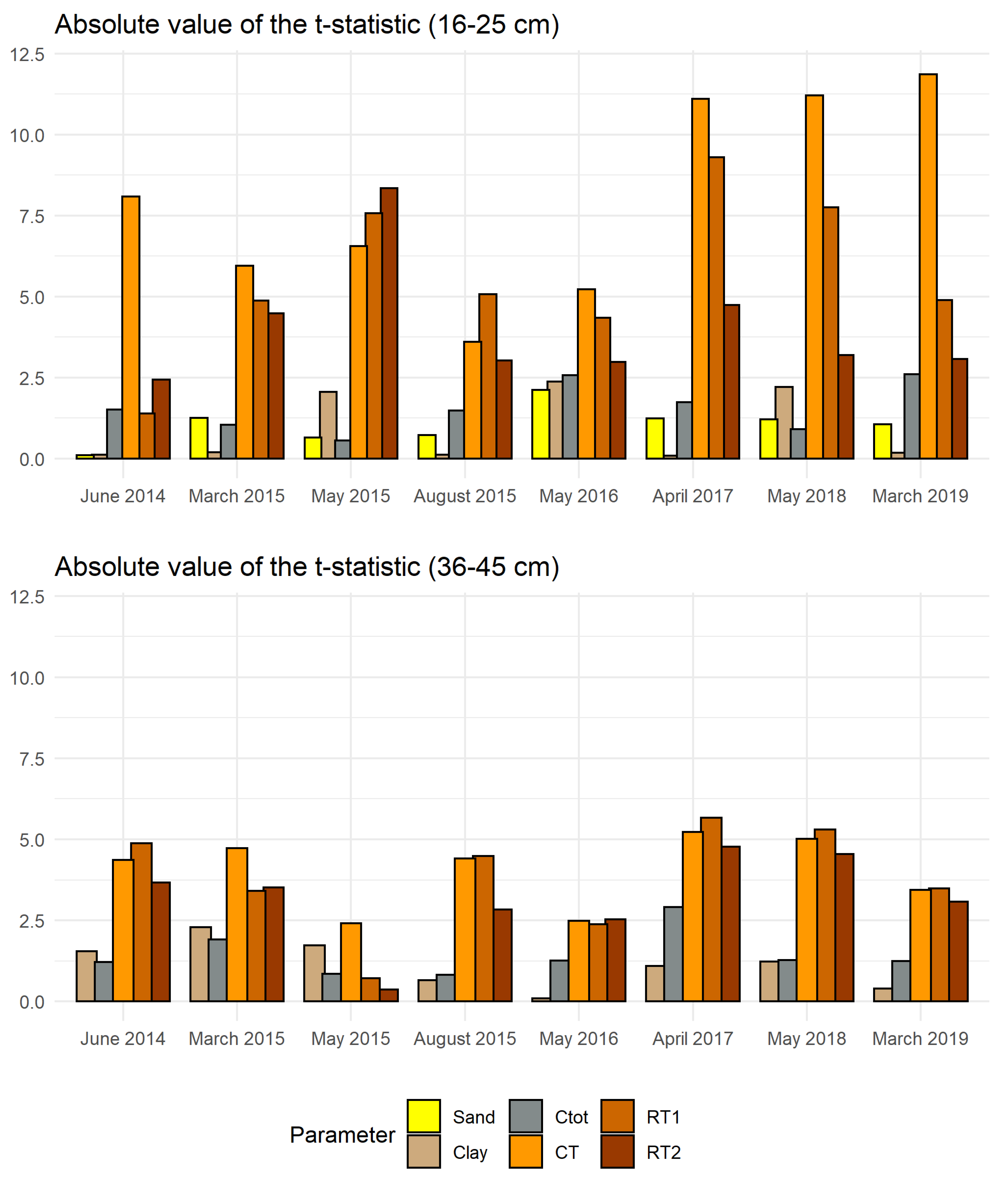
| Year | Field Crop | Primary Tillage | Sowing | Harvest | Fieldwork |
|---|---|---|---|---|---|
| 2014 | Sugar beets | 20–21 March 2014 | 23 April 2014 | 8 and 16 October 2014 | 10–14 March a and 11–13 June b 2014 |
| 2014/15 | Winter wheat | 18 October 2014 | 18 October 2014 | 13 August 2015 | 23–27 March bc, 26–29 May bc, 19–21 August bc 2015 |
| 2016 | Maize | 21 and 22 April 2016 | 23 April 2016 | 27 September 2016 | 9–11 May b 2016 |
| 2016/17 | Winter wheat | 4 October 2016 | 4 October 2016 | 9 August 2017 | 10–11 April b 2017 |
| 2018 | Sugar beets | 8 and 9 April 2018 | 10 April 2018 | 25 October 2018 | 6–9 May bc 2018 |
| 2018/19 | Winter wheat | 26 October 2018 | 26 October 2018 | 30 July 2019 | 25–29 March bc 2019 |
| Depth in cm | Depth in cm | |||||||||||
|---|---|---|---|---|---|---|---|---|---|---|---|---|
| 6–15 | 16–25 | 26–35 | 36–45 | 6–15 | 16–25 | 26–35 | 36–45 | |||||
| June 2014 a | CT-RT1 | n.s. | *** | *** | n.s. | May 2016 b | CT-RT1 | n.s. | n.s. | n.s. | n.s. | |
| CT-RT2 | n.s. | *** | *** | n.s. | CT-RT2 | ** | *** | n.s. | n.s. | |||
| RT1-RT2 | n.s. | n.s. | n.s. | ** | RT1-RT2 | *** | n.s. | n.s. | n.s. | |||
| HL-IF | ** | ** | *** | *** | HL-IF | n.s. | *** | *** | ** | |||
| March 2015 b | CT-RT1 | n.s. | n.s. | n.s. | n.s. | April 2017 b | CT-RT1 | n.s. | *** | *** | n.s. | |
| CT-RT2 | n.s. | n.s. | n.s. | n.s. | CT-RT2 | *** | *** | *** | n.s. | |||
| RT1-RT2 | n.s. | n.s. | n.s. | n.s. | RT1-RT2 | *** | *** | *** | n.s. | |||
| HL-IF | *** | *** | *** | *** | HL-IF | n.s. | *** | *** | *** | |||
| May 2015 b | CT-RT1 | n.s. | n.s. | n.s. | n.s. | May 2018 b | CT-RT1 | ** | *** | *** | n.s. | |
| CT-RT2 | n.s. | n.s. | n.s. | ** | CT-RT2 | *** | *** | *** | n.s. | |||
| RT1-RT2 | n.s. | n.s. | n.s. | n.s. | RT1-RT2 | *** | *** | ** | n.s. | |||
| HL-IF | n.s. | *** | *** | n.s. | HL-IF | n.s. | *** | *** | *** | |||
| August 2015 b | CT-RT1 | ** | n.s. | n.s. | n.s. | March 2019 b | CT-RT1 | ** | *** | ** | n.s. | |
| CT-RT2 | n.s. | n.s. | ** | n.s. | CT-RT2 | *** | *** | ** | n.s. | |||
| RT1-RT2 | n.s. | n.s. | n.s. | n.s. | RT1-RT2 | *** | n.s. | n.s. | n.s. | |||
| HL-IF | *** | *** | *** | *** | HL-IF | n.s. | *** | *** | *** | |||
| March 2015 | May 2015 | August 2015 | May 2018 | March 2019 | ||||||
|---|---|---|---|---|---|---|---|---|---|---|
| Tillage Plot | VSWC % | BD g/cm3 | VSWC % | BD g/cm3 | VSWC % | BD g/cm3 | VSWC % | BD g/cm3 | VSWC % | BD g/cm3 |
| CT | 38.5 (±1.1) a | 1.43 (±0.03) a | 25.2 (±0.3) a | 1.55 (±0.03) a | 36.0 (±0.6) a | 1.44 (±0.01) a | 29.3 (±2.2) a | 1.27 (±0.06) a | 31.7 (±0.6) a | 1.31 (±0.02) a |
| RT1 | 35.8 (±2.2) ab | 1.40 (±0.04) a | 24.9 (±2.0) a | 1.55 (±0.05) a | 34.9 (±0.4) b | 1.45 (±0.03) a | 32.1 (±2.2) a | 1.36 (±0.06) b | 31.8 (±1.1) a | 1.39 (±0.03) b |
| RT2 | 34.6 (±1.9) bc | 1.38 (±0.06) a | 24.5 (±4.1) a | 1.54 (±0.09) a | 33.8 (±1.2) b | 1.46 (±0.02) a | 33.4 (±0.9) a | 1.46 (±0.03) c | 31.9 (±1.0) a | 1.45 (±0.03) c |
Publisher’s Note: MDPI stays neutral with regard to jurisdictional claims in published maps and institutional affiliations. |
© 2020 by the authors. Licensee MDPI, Basel, Switzerland. This article is an open access article distributed under the terms and conditions of the Creative Commons Attribution (CC BY) license (http://creativecommons.org/licenses/by/4.0/).
Share and Cite
Kuhwald, M.; Hamer, W.B.; Brunotte, J.; Duttmann, R. Soil Penetration Resistance after One-Time Inversion Tillage: A Spatio-Temporal Analysis at the Field Scale. Land 2020, 9, 482. https://doi.org/10.3390/land9120482
Kuhwald M, Hamer WB, Brunotte J, Duttmann R. Soil Penetration Resistance after One-Time Inversion Tillage: A Spatio-Temporal Analysis at the Field Scale. Land. 2020; 9(12):482. https://doi.org/10.3390/land9120482
Chicago/Turabian StyleKuhwald, Michael, Wolfgang B. Hamer, Joachim Brunotte, and Rainer Duttmann. 2020. "Soil Penetration Resistance after One-Time Inversion Tillage: A Spatio-Temporal Analysis at the Field Scale" Land 9, no. 12: 482. https://doi.org/10.3390/land9120482
APA StyleKuhwald, M., Hamer, W. B., Brunotte, J., & Duttmann, R. (2020). Soil Penetration Resistance after One-Time Inversion Tillage: A Spatio-Temporal Analysis at the Field Scale. Land, 9(12), 482. https://doi.org/10.3390/land9120482





